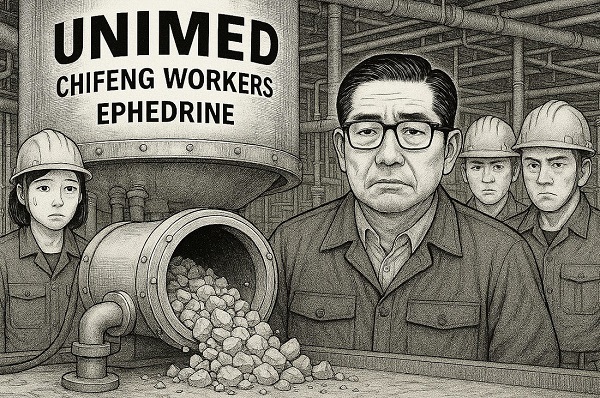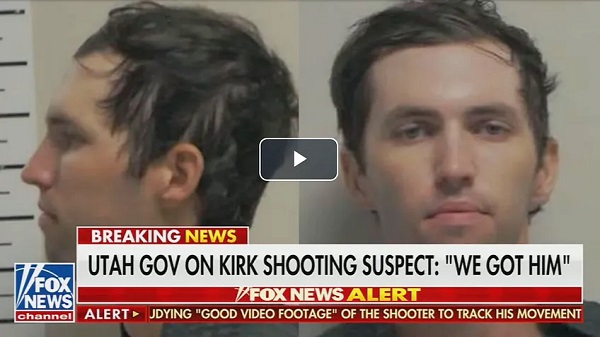Crime
How Chinese State-Linked Networks Replaced the Medellín Model with Global Logistics and Political Protection

Zhenli Ye Gon, aka “El Chino” ran a meth empire from Mexico City supplied and set up by a Chinese Communist Party linked conglomerate called Chifeng Arker.
The Rise of ‘El Chino’ — A New Blueprint for Beijing’s Narco-Industrial Power
In the 1980s and ’90s, U.S. agents dismantled the Medellín Cartel not by chasing Pablo Escobar directly, but by targeting the structure around him—the lawyers, accountants, and corporate fixers who laundered his fortune. For Don Im, a key figure in the DEA’s inner circle during that campaign, it was a hard-won lesson that stayed with him across decades of global narcotics investigations.
“You can take down the cartels all you want—cartels are easy to replace,” Im told The Bureau. “It’s the bankers, the businessmen, the lawyers, and the accountants that are harder to get. Because they’re the inconvenient targets.”
By “inconvenient,” Im means politically protected. Ultimately, geopolitically protected.
Today, he sees history repeating itself—only on a far more dangerous scale. Where Colombian cocaine traffickers once flooded American cities, Chinese-backed methamphetamine and fentanyl empires now dominate, shielded by Party-state logistics and financial infrastructure. The operations are more sophisticated—executed with near impunity.
“I worked with Steve and Javier,” Im said, referencing DEA agents Javier Peña and Steve Murphy, the duo immortalized in Narcos. “And how Pablo was taken down? His accountants and lawyers were the first to be removed. That made Pablo a bigger, more vulnerable target. Unless we go after the facilitators—accountants, lawyers, businessmen, and corrupt government officials—you’re never going to affect the illicit drug trade or the money it generates.”
That insight brings Im back to a dilemma that continues to trouble him, even three years into retirement: how to dismantle narco empires entrenched in Canada and Mexico, shielded not only by senior Chinese Communist officials profiting from the fentanyl trade, but also by troubling ties to Western political figures. The conundrum, he says, is captured in what some DEA veterans view as the most overlooked turning point in global narco-trafficking—the rise of Chinese-Mexican pharmaceutical magnate Zhenli Ye Gon.
Now imprisoned in Altiplano, Mexico’s maximum-security fortress, Ye Gon was a legendary figure in Las Vegas—dubbed the “Mexican-Chinese whale” for his extravagant losses at casinos like the Venetian, where he gambled over $125 million between 2004 and 2007, all while running a billion-dollar methamphetamine empire.
His ascent in Western Hemisphere drug trafficking was too rapid to be accidental.
“I think he arrived in Mexico City in 1998 or 1999,” Im recalled. “And then within two years, he received Mexican citizenship from President Vicente Fox. So that shows you how influential and effective he was in penetrating the highest levels of the Mexican government.”
Once established in Mexico, his pipeline to CCP-linked suppliers began flooding Mexican ports—with a high-end production facility built with technical assistance from China.
“He’s still in prison asking for another $270 million back—after $207 million was already seized,” Im said, his voice tightening with outraged disbelief. “And he’s still sitting there. He was the largest pseudoephedrine importer from China into Mexico. His companies and infrastructure are still intact.”
When asked who is running the infrastructure today, Im didn’t hesitate.
“His associates and his family members.”
“He imported seven or eight high-powered, top-of-the-line pill press machines from Germany—each capable of cranking out at least half a million pills every two days,” Im said. “The Mexican authorities seized one.”
That leaves a troubling question: Have the remaining pill presses continued producing fentanyl-laced counterfeit oxycodone pills for the past decade—operated by Ye Gon’s family members and Chinese-linked criminal associates, in alliance with the Sinaloa Cartel—even as he sits in prison, with impeccable supply ties to Chinese Communist Party-controlled precursor firms still intact?
The Bureau’s review of DEA records and U.S. extradition documents suggests Ye Gon’s operations extended far beyond chemicals and a single Mexican factory built with assistance from a Chinese precursor supplier. His financial network revealed a laundering architecture as vast and deliberate as his synthetic drug supply chain.
According to DEA calculations, Ye Gon’s company illegally imported nearly 87 metric tons of a key methamphetamine precursor over just a few years—enough to yield more than 36 metric tons of high-purity meth. At conservative estimates, the precursor was worth over USD $188 million. Once converted and sold on American streets, the finished product could generate more than USD $724 million.
Chemical Supply Meets Political Shield: Chifeng Arker’s Role in the Fentanyl Pipeline
On September 24, 2003, Ye Gon’s Mexico-based firm, Unimed México, signed a supply contract with Chifeng Arker, a company based in Inner Mongolia with links to Shanghai. The deal called for the annual purchase of at least 50 metric tons of a chemical used to manufacture pseudoephedrine—a primary precursor in the production of methamphetamine. Once processed, the substance forms the essential base for high-purity crystal meth.
While Washington remains rightly focused on the toll of fentanyl, Im says the devastation wrought by methamphetamine is comparable. Beyond generating revenue to fund fentanyl production, meth ravages communities and drains health care and policing budgets in blighted states.
The scale at which Ye Gon operated—importing dozens of tons of precursors and building a high-end production plant—could not realistically have been achieved without tacit support from elements of the Chinese state.
In effect, Chifeng Arker agreed not only to supply enormous volumes of this chemical, but also to support Ye Gon in running his Mexican production plant.
“The contract also called for Chifeng Arker to provide technical support to aid Unimed in the actual production of pseudoephedrine, to include ‘workshop housing design,’” U.S. government extradition records state. “In October 2005, Ye Gon began to build and equip a manufacturing plant in Toluca, Mexico, with the help of Chinese advisors, as contemplated by the September 2003 contract with Chifeng Arker.”
Both Ye Gon and his chief chemist, Bernardo Mercado Jiménez, signed the agreement.
Court records suggest Ye Gon and a team of Chinese workers were directly involved in methamphetamine production.
“Chinese workers helped with the start-up of that plant, as contemplated by the Chifeng Arker contract,” states a 2013 U.S. District Court extradition filing from West Virginia. The filing continues: “According to workers at the plant, the facility received daily shipments of a white, hard chemical substance that was heated with hydrochloric acid to obtain a white crystalline powder. … At the end of the day, that powder was bagged and driven away by Ye Gon or his personal driver.”
Pursuant to the contract, shipments of precursor chemicals flowed from China to Mexico between 2004 and 2006. After mid-2005, Mexico revoked its license amid a chemical diversion crackdown. Ye Gon and Chifeng Arker shifted to more covert methods.
Evidence from U.S. court and extradition records shows that at least four large illicit shipments—totaling tens of thousands of kilograms—were dispatched in 2005 and 2006. To avoid scrutiny, they were routed through a Hong Kong shell company called Emerald Import & Export and labeled misleadingly.
During this period, Chifeng Arker effectively served as Ye Gon’s offshore factory, supplying raw materials for meth production.
The financial connection ran just as deep. Ye Gon used Mexican currency exchanges—casas de cambio—to launder payments to Chifeng Arker. In one documented instance, a single exchange processed three payments totaling $2 million USD to Arker, timed to coincide with the Hong Kong shipments.
Corporate record searches show that Chifeng changed its ownership structure after scrutiny from U.S. authorities. Its current parent company in Shanghai—publicly traded in Hong Kong—is nearly 50 percent owned by state-controlled or linked pharmaceutical firms, with 29 percent held by the Shanghai State-owned Assets Supervision and Administration Commission (SASAC).
This structure underpins what DEA experts like Im argue: that major figures such as Zhenli Ye Gon—and, even more so, his Chinese Canadian counterpart Tse Chi Lop—serve as “command and control” for the Western Hemisphere’s fentanyl and money laundering networks. Their global narco empires, Im says, operate with the knowledge, protection, and involvement—sometimes directly—of senior Chinese Communist Party officials.
The staggering scale of these synthetic narco empires—decentralized across North America, yet rooted in state-directed chemical output from Communist Party-controlled or Party-influenced firms such as Chifeng—is reflected in the DEA affidavit that led to Ye Gon’s conviction.
When Mexican prosecutors raided his Mexico City residence in 2007, they found $205.5 million in U.S. cash stacked in suitcases, closets, and false compartments. Another $2 million in foreign currency and traveler’s checks was seized along with luxury goods, high-end jewelry, and receipts from Las Vegas casinos. Federal agents also confiscated seven firearms, including a fully automatic AK-47.
Equally disturbing was a handwritten note found among Ye Gon’s seized records. “Due to the detention of the flour, my associates and I had some problems,” it read. “I have contact with customs. Call me to work.” Investigators interpreted “flour” as code for a seized chemical shipment, and “books” as shorthand for drug proceeds. The reference to “contact with customs” pointed to a corrupt facilitator within Mexico’s border control system—an insider positioned to keep the chemical pipeline open. For veteran DEA agents, it was a textbook indicator of entrenched, systemic corruption.
Federal agents later executed a search warrant at UNIMED’s corporate headquarters in Mexico City. There, they discovered an additional $111,000 in cash, along with records for bank accounts in the United States, China, and Hong Kong. Wire transfer receipts and confirmation pages linked UNIMED to Mexican currency exchanges, detailing the flow of funds from Mexico into accounts across the United States and Europe.
“From a law enforcement standpoint,” the affidavit stated, “these casas de cambio have been widely used by drug trafficking organizations in Mexico and South America to insert their illegal drug proceeds into the legitimate world financial systems in an attempt to disguise the origin of the money and launder its criminal history.”
The DEA affidavit reads like an early blueprint—one that foreshadowed the global expansion of Chinese money laundering and chemical dominance over synthetic drug production.
It documents how, by 2004, escalating U.S. enforcement and tighter international controls on precursors like pseudoephedrine forced methamphetamine production out of the United States and into Mexico. By 2006, Mexican authorities had seized what were then the two largest meth labs in the Western Hemisphere. These industrial-scale operations were directly linked to trafficking routes into the United States and supplied by Chinese precursor chemicals. They marked the emergence of a decentralized manufacturing model—one that has since migrated north and now operates inside Canada.
The affidavit also provides forensic insight into how, beginning in the early 2000s, Chinese state-linked traffickers assumed control over global money laundering for ultra-violent Latin American cartels.
While Ye Gon’s reputation as a high-rolling gambler—losing at least $125 million in Las Vegas casinos between 2004 and 2007—is well documented, what appears to have gone unreported is that the DEA’s Las Vegas field office obtained intelligence directly tying his casino activity to laundering operations for a major Mexican drug cartel.
“A Mexican organized crime group began blackmailing YE GON in México,” stated an affidavit by DEA Special Agent Eduardo A. Chávez. “According to YE GON, the group wanted to store cash at YE GON’s residence in México City. In addition to storing cash, the group wanted YE GON to launder their money. YE GON told the source that he knew the money in his house was ‘dirty money’ and the proceeds of narcotics trafficking. YE GON told the source that he continually received threats against himself and his family, so he believed that he had no choice but to launder the money. YE GON told the source that the traffickers instructed him to use his bank accounts to send the money to Las Vegas, where he could launder it.”
It’s just one vivid example of the deep integration between Chinese money launderers and Mexican cartels. While the cartels clearly operate with a brutality that commands respect—and sometimes fear—from their Chinese partners, ultimately, it is the Chinese networks that reign supreme: they control the finance, the chemicals, and the decentralized factory components underpinning the global trade. As Ye Gon’s case indicates, they sit at commanding heights.
Target the Enablers or Lose the War
The case documented a tectonic shift: the outsourcing of cartel financial operations to Chinese actors—and a new era of synthetic narco-capitalism governed not by territorial control, but by logistical mastery.
DEA agents tracking that shift—the transfer of global laundering and chemical command to China—soon formalized their findings within a strategic U.S. intelligence framework. While Don Im was leading DEA financial operations in New York, the U.S. government launched an initiative known as Linkage, designed to map the evolving East Asian narcotics supply architecture. The strategy identified how Chinese and Southeast Asian syndicates operated like a chain of interlocking specialists in chemical production, international transport, and financial laundering.
“Linkage was an initiative to identify the entire supply chain from the United States back into Southeast Asia,” Im recalled. “They called it Linkage because the way Chinese and other Asian traffickers were operating was like a chain: independent manufacturers, independent transporters, independent distributors—all linked. They didn’t work for one another, they worked with one another, relying on their specialties—production, transportation, smuggling, distribution.”
The other side of the counter-narcotics effort was the Linear Initiative, which attacked the supply chain flowing from Bolivia, Peru, and Colombia into the U.S. Today, those organizations outsource laundering to Chinese brokers—who need the cash, while the cartels need access to their polydrug profits in North America, Europe, and Australia.
This led directly to one of the most controversial cases of the era: HSBC.
Operation Royal Flush—an extension of both Linkage and Linear—targeted the financial backbone of these networks by tracing dirty cash upstream to their command centers.
“We targeted a South American bank and ended up identifying HSBC as essentially just blatantly violating anti-money laundering laws, rules, and regulations,” Im said. “We realized they were helping facilitate not just Mexican cartels, but South American cartels, Russian organized crime, Chinese organized crime, Italian organized crime—all throughout the world. And they just got a slap on the wrist: a $1.9 billion fine.”
The case continues to reverberate inside the DEA—especially after agents watched with disbelief as Canadian authorities recently imposed just a $9 million fine on TD Bank, despite mounting evidence of large-scale fentanyl money laundering through its North American branches, orchestrated from Toronto. For years, the activity appeared to proceed largely unchecked, even as Canadian police and senior political officials were warned of systemic vulnerabilities by the country’s financial intelligence agency, FINTRAC. Only after DEA investigators, working through the U.S. Department of Justice, advanced a sweeping probe did the true scale of the operation begin to surface.
According to sources including former U.S. State Department investigator David Asher, the case involved Chinese international students and underground bankers funneling drug cash into bank branches across the Tri-State area. Investigators traced “command and control” links to the Triad syndicate led by Tse Chi Lop—an empire rooted in Toronto and Vancouver, with longstanding ties to the Chinese Communist Party and direct links to precursor chemical factories that generate GDP for Beijing.
This brings Don Im’s most troubling observations into sharp focus—particularly Ottawa’s handling of the TD Bank case, and his deeper concern that the only effective way to confront fentanyl trafficking is to follow the money all the way to the top of political and corporate power. But that, he reiterates, is also the path into politically “inconvenient” territory.
In many ways, Im believes, following the money to the highest levels of Western enablers—once so effective in dismantling Pablo Escobar’s empire—has become a lost art. And one, he argues, that must be revived.
What he now calls for is a no-holds-barred international campaign—led by informed citizens and coordinated governments—from Vancouver to West Virginia.
“These same cartels, brokers, and Chinese precursor suppliers behind the fentanyl crisis in North America are also pushing cocaine, heroin, and meth in Europe and Australia—and Canada,” Im said.
The DEA must expand its global presence, Im argues, and embed sources deep inside the very organizations responsible for poisoning the West.
“And the nonsense view that only fentanyl should be targeted is absolutely mind-boggling,” he said. “Profits from heroin, cocaine, methamphetamine are used to produce fentanyl.”
For Im, the stakes are no longer merely criminal—they are existential. The West, he believes, is locked in an asymmetric conflict with Beijing.
“The Chinese Communist Party at all levels has been aware of the magnitude of global drug trafficking and, specifically, the cheap and easily available liquid capital and cash that can be purchased, bartered, converted, invested for any beneficial CCP-sponsored initiative—directly or indirectly—and satisfies elements of corruption at every level,” Im told The Bureau. “This is in line with the 100-year vision to expand their influence—not to destroy the West but to plunder and exploit the wealth, technology, and abundant liquid capital from the massive drug trade in North American and European consumer cities for their benefit.”
Next in this series: Narco-Funded Belt and Road
The Bureau is a reader-supported publication.
To receive new posts and support my work, consider becoming a free or paid subscriber.
Editor’s Note: Don Im shares this message in conjunction with The Bureau’s ongoing investigative series, which aims to inform international policy responses to the Chinese Communist Party’s role in facilitating a hybrid fentanyl war.
“I followed and worked with many incredible agents, task force members, and intelligence analysts from the DEA, FBI, legacy U.S. Customs, IRS, RCMP, and DOJ prosecutors—professionals who dedicated their lives to combatting Asian organized crime. These unsung heroes risked their lives. Two DEA Special Agents—Paul Seema and George Montoya—gave their lives in 1988, and DEA Special Agent Jose Martinez was wounded in this war. Their dedication, efforts, and impact live on in the criminal data systems of the various agencies.”
Invite your friends and earn rewards
Crime
Down the Charlie Kirk Murder Rabbit Hole

- Tyler Robinson’s dad is not a cop but in construction.
- The idea of a wider conspiracy is more credible today.
- Discord is the platform that Robinson used. Twitch is also a gaming platform and one that hosts a great deal of inflammatory speech against MAGA and conservatives more generally.
- The trans story connection from Thursday is taking off with yet another odd festishistic twist. Wait for it.
My credentials do come into play somewhat here and you deserve to know them. I worked at the highest levels of true crime investigation and reporting for many years. In cases like this, experience matters. A number of grifters have emerged to monetize this story. Including the bizarre contention that the rise of Charlie Kirk haters posting on social media is a “psy-op” which is easily debunked. They are real accounts with actual bios attached and the posters whose names are on them are being fired and punished. Demonstrably provable.
On background — our team overturned the conviction of a Nova Scotia man wrongfully convicted of murdering his wife. We uncovered evidence that Karla Homolka was more likely than Paul Bernardo to have murdered their victims. It was the highest rated crime reporting in the history of the CBC. Later, I investigated and further exposed a spate of wrongful convictions on Chicago’s South Side that send many young black men to prison for murders they didn’t commit. There are more but let’s leave it at that.
Are we being lied to? No doubt. My advice: stay away from the influencers and rage farmers. They will not make us smarter.
So what do we have? We have a narrative around Tyler Robinson which gets weirder by the minute. And we have an emerging idea around Israel that I rejected in the podcast but am curious about after reading a piece by Max Blumenthal. Kirk was turning away from the Zionist billionaires who’d helped fund TPUSA and they had started threatening him for questioning the America/Israel collaboration. Kirk was also questioning Israel/Gaza and America’s blind attachment. I apologize to Chris Bray our brilliant guest for not giving him a chance to comment on this as I am sure he has something to say. I found the Grayzone piece after we recorded.
Stick with me. I am posting here the entire Grayzone article. Please read it and comment but keep it cool. At this point — can we take anything off the table?
A Trump insider and longtime friend of Charlie Kirk tells The Grayzone how the assassinated conservative leader’s turning point on Israeli influence provoked a private backlash from Netanyahu’s allies that left him angry and afraid.
The source said anxiety spread within the Trump administration after an apparent Israeli spying operation was uncovered.
Charlie Kirk rejected an offer earlier this year from Israeli Prime Minister Benjamin Netanyahu to arrange a massive new infusion of Zionist money into his Turning Point USA (TPUSA) organization, America’s largest conservative youth association, according to a longtime friend of the slain commentator speaking on the condition of anonymity. The source told The Grayzone that the late pro-Trump influencer believed Netanyahu was trying to cow him into silence as he began to publicly question Israel’s overwhelming influence in Washington and demanded more space to criticize it.
In the weeks leading up to his September 10 assassination, Kirk had come to loathe the Israeli leader, regarding him as a “bully,” the source said. Kirk was disgusted by what he witnessed inside the Trump administration, where Netanyahu sought to personally dictate the president’s personnel decisions, and weaponized Israeli assets like billionaire donor Miriam Adelson to keep the White House firmly under its thumb.
According to Kirk’s friend, who also enjoyed access to President Donald Trump and his inner circle, Kirk strongly warned Trump last June against bombing Iran on Israel’s behalf. “Charlie was the only person who did that,” they said, recalling how Trump “barked at him” in response and angrily shut down the conversation. The source believes the incident confirmed in Kirk’s mind that the president of the United States had fallen under the control of a malign foreign power, and was leading his own country into a series of disastrous conflicts.
By the following month, Kirk had become the target of a sustained private campaign of intimidation and free-floating fury by wealthy and powerful allies of Netanyahu – figures he described in an interview as Jewish “leaders” and “stakeholders.”
“He was afraid of them,” the source emphasized.
At TPUSA, the rift with Israel widens
Kirk was 18 years old when he launched TPUSA in 2012. From its inception, his career was propelled by Zionist donors, who showered his young organization with money through neoconservative outfits like the David Horowitz Freedom Center. He repaid his wealthy backers over the years by unleashing a relentless firehose of anti-Palestinian and Islamophobic diatribes, accepting propaganda trips to Israel, and sternly shutting down nationalist forces challenging his support for Israel during TPUSA events. In the Trump era, few American gentiles had proved more valuable to the self-proclaimed Jewish state than Charlie Kirk.
But as Israel’s genocidal assault on the besieged Gaza Strip drove an unprecedented backlash within grassroots right-wing circles, where only 24% of younger Republicans now sympathize with Israel over the Palestinians, Kirk began to shift. At times, he toed the Israeli line, spreading disinformation about babies beheaded by Hamas on October 7, and denying the famine imposed on the population of Gaza. Yet he simultaneously ceded to his base, wondering aloud if Jeffrey Epstein was an Israeli intelligence asset, questioning whether the Israeli government allowed the October 7 attacks to proceed in order to advance long-term political goals, and parroting narratives familiar to his most vociferous critic on the right, streamer Nick Fuentes.
This July, at his TPUSA Student Action Summit, Kirk provided a forum for the right-wing grassroots to vent its fury about Israel’s political hammerlock on the Trump administration. There, speakers from former Fox News stalwarts Tucker Carlson and Megyn Kelly, to the anti-Zionist Jewish comedian Dave Smith, denounced Israel’s blood-soaked assault on the besieged Gaza Strip, branded Jeffrey Epstein as an Israeli intelligence asset, and openly taunted Zionist billionaires like Bill Ackman for “getting away with scams” despite having “no actual skills.”
Following the confab, Kirk was bombarded with infuriated text messages and phone calls from Netanyahu’s wealthy allies in the US, including many who had funded TPUSA. According to his longtime friend, the Zionist donors treated Kirk with outright contempt, essentially ordering him to fall back into line.
“He was being told what you’re not allowed to do, and it was driving him crazy,” Kirk’s friend recalled. The conservative youth leader was not only alienated by the hostile nature of the interactions, but “frightened” by the backlash.
The friend’s account dovetails with those of multiple right-wing commentators with access to Kirk.
“I think, in the end, Charlie was going through a spiritual transformation,” Candace Owens, a conservative influencer who shifted decisively against Israel after October 7, reflected after her friend’s killing. “I know it, he was going through a lot. There was a lot of pressure, and it’s hard for me to watch the people who were pressuring him just say the things that they’re saying.”
She continued: “They wanted him to lose everything for changing or even slightly modifying an opinion. It’s very hurtful to me.”
Kirk appeared visibly outraged during an August 6 interview with conservative host Megyn Kelly, as he discussed the menacing messages he was receiving from pro-Israel bigwigs.
“It’s all of the sudden: ‘oh, Charlie: he’s no longer with us.’ Wait a second—what does ‘with us’ mean, exactly? I’m an American, okay? I represent this country,” he explained, before addressing the powerful Zionist interests harassing him.
“The more that you guys privately and publicly call our character into question—which is not isolated, it would be one thing if it were just one text, or two texts; it is dozens of texts—then we start to say, ‘whoa, hold the boat here,’” Kirk continued. “To be fair, some really good Jewish friends say, ‘that’s not all of us’… But these are leaders here. These are stakeholders.”
He went on to complain to Kelly, “I have less ability… to criticize the Israeli government than actual Israelis do. And that’s really, really weird.”
In one of his final interviews, conducted with Israel’s premier influencer in the United States, Ben Shapiro, Kirk once again tried to raise the issue of censorship of Israel critics.
“A friend said to me, interestingly: ‘Charlie, okay, we’ve pushed back against the media on COVID, on lockdowns, on Ukraine, on the border,’” Kirk told Shapiro on September 9. “Maybe we should also ask the question: is the media totally presenting the truth when it comes to Israel? Just a question!”
According to Kirk’s longtime friend, Kirk’s resentment of Netanyahu and the Israel lobby was spreading within Trump’s inner circle. In fact, they said, the president himself was terrified of Netanyahu’s wrath, and feared the consequences of defying him.
During the past year, the Trump insider was told by contacts in the White House that the Secret Service had caught Israeli government personnel placing electronic devices on its emergency response vehicles on two separate occasions.
While The Grayzone was unable to confirm the story with the Secret Service or White House, such an incident would not have been unprecedented. Indeed, according to a report in Politico citing three former senior US officials, a cellphone spying device was placed by Israeli agents “near the White House and other sensitive locations around Washington” toward the end of Trump’s first term in 2019.
Former UK Prime Minister Boris Johnson recounted a similar incident in his memoir, writing that his security team found a listening device in his bathroom soon after Netanyahu used his personal toilet.
The Israel-did-it theory
Kirk was killed this September 10 with a single shot fired by a sniper apparently positioned on a rooftop 200 meters away. He was shot while seated before a crowd of thousands at Utah Valley University in Orem, Utah on the first leg of his American Comeback Tour. The scene of Kirk collapsing from the impact of a gunshot to his neck just as he began answering a question about transgender mass shooters was perhaps the most shockingly vivid spectacle of assassination – and certainly the most viral – in human history.
There is currently no evidence of an Israeli government role in Kirk’s assassination. However, that has not stopped thousands of social media users from speculating that the pro-Trump operative’s shifting views on the issue contributed in some way to his death. By the time of publication, over 100,000 Twitter/X users have liked a September 11 post by libertarian influencer Ian Carroll declaring about Kirk, “He was their friend. He basically dedicated his life to them. And they murdered him in front of his family. Israel just shot themselves.”
Many advancing the unsubstantiated theory have pointed to a Twitter/X post by Harrison Smith, a personality at the pro-Trump Infowars network, stating on August 13 – almost a month before Kirk’s assassination – that he was told by “someone close to Charlie Kirk that Kirk thinks Israel will kill him if he turns against Israel.”
The frenzied speculation has set off shockwaves in Tel Aviv, where Netanyahu was compelled to explicitly deny that his government killed Kirk during a September 11 interview with NewsMax.
Netanyahu and his allies bury the Kirk crisis as “big tent” collapses
That appearance was just one of several interviews and statements the Prime Minister dedicated to Kirk in the wake of his killing in an effort to frame the late conservative leader’s legacy in a uniformly pro-Israel light. The major public relations push has occurred while Netanyahu wages a military campaign on seven fronts, punctuated by a regional assassination spree that most recently reached into the heart of Qatar, a US ally.
Netanyahu first tweeted prayers for Kirk at 3:02 PM in the afternoon on September 10, minutes after news of the shooting broke. He has since authored three additional posts about Kirk, even breaking away from the Israeli war cabinet to spend the afternoon of September 11 memorializing the conservative leader on Fox News.
During that interview, Netanyahu did his best to insinuate that Israel’s enemies were responsible for murdering Kirk, despite the fact no suspect was named or in custody at the time:
“The radical Islamists and their union with the ultra-progressives—they often speak about ‘human rights,’ they speak about ‘free speech’—but they use violence to try to take down their enemies,” the Prime Minister told Harris Faulkner.
In a September 10 Twitter/X post eulogizing the conservative leader, the Israeli Prime Minister described a recent phone conversation with Kirk.
“I spoke to him only two weeks ago and invited him to Israel,” Netanyahu declared. “Sadly, that visit will not take place.”
Left unmentioned was whether Kirk declined the invitation—just as he did with the Prime Minister’s offer to reload TPUSA’s coffers with donations from his coterie of wealthy American Jewish cutouts.
At the time of publication, a 22-year-old resident of Utah has been taken into custody after supposedly confessing to killing Kirk. The public may soon learn the true motives of the alleged assassin. Perhaps they will fuel the narrative which Trump and his allies advanced in the immediate wake of the shooting – that a leftist radical was responsible, and that a wave of draconian repression must follow.
But after the shooter’s initial escape and a series of federal law enforcement mishaps, a large sector of Americans will likely never believe the official story. Nor will they ever know where Kirk’s turning point on Israel would have taken the conservative movement.
Four days before the assassination, frustration among pro-Israel commentators bubbled over in public during an Fox News interview in which Ben Shapiro launched a chilling attack on Kirk without naming him.
“The problem with a ‘big tent’ is that you may end up with many clowns inside,” Shapiro told Fox host and fellow Zionist gatekeeper Mark Levin in an apparent critique of TPUSA.
“Just because you’re saying somebody votes Republican—that doesn’t mean that they ought to be the preacher at the front of the church, they’re not the person that ought to be leading the movement, if they are spending all day criticizing the President of the United States as ‘covering up a Mossad rape ring’ or ‘being a tool of the Israelis for hitting an Iranian nuclear facility.’”
When Kirk took his usual place at the “front of the church” four days later, he was cut down by a sniper’s bullet.
Within 24 hours of Kirk’s death, Shapiro announced that he would be launching his own campus speaking tour, vowing: “We’re gonna pick up that blood stained microphone where Charlie left it.”
Ben ShapiroBenjamin NetanyahuCharlie KirkConservativesDonald TrumpFox NewsGazaGOPIsraelIsrael-
END OF GRAYZONE PIECE
Back to Tyler Robinson:
Earlier there was some evidence reported by Steven Crowder and the Wall Street Journal of a trans connection based on etchings in the shell casings. That was later softened and then debunked when the actual markings were officially confirmed by the FBI. But hold on to your hats….the markings actually refer to a modern kink known as “furry”— a sad subculture which is LGBTQ adjacent in which adherents get their kicks by dressing in plush animal costumes. Andy Ngo’s extensive reporting on Antifa suggests a link between trans/furry and some of the violence that attended the BLM riots. Remember the mug shots?
Then the story got weirder. On Saturday, Fox and then the New York Post reported that the “roommate” who was working with police is actually Robinson’s romantic partner with whom he lived. Lance Twiggs identifies as trans and it was reported Twiggs is in the process of “transition.” Below is Twiggs in his furry gear.
This revelation is a full circle moment given that Kirk was in the middle of discussing trans violence when he was shot. Robinson’s family is not ruling out trans anger as a motive for the shooting. Kirk’s final words before the fatal shot.
“Do you know how many transgender Americans have been mass shooters over the last 10 years?” Kozak asked. While Kirk said “too many,” Kozak contended the number was five.
Kirk’s final words were a question to Kozak for clarity on the number. He asked whether that was “counting or not counting gang violence.” That’s when the shot rang out, ending the 31-year-old activist’s life.
My question: Was the shooting of Charlie Kirk a misguided gesture of love/commitment by Robinson aimed at his trans/furry boyfriend?
The story about Tyler Robinson is a compelling one but obviously we don’t know enough. Will he die in prison before a trial?
NEW-THE SECURITY ANGLE:
What is clear and it is the obvious question that no one is talking about — why was security for Kirk so apparently lax going into an event that was in hugely hostile territory. Did the TPUSA team even know about the pushback from students and that credible threats were made in the days leading up to it? This was a replay of Butler. Why no sweep of the rooftops?
Perhaps Robinson was aware of this story and petition against Kirk in the University Newspaper. Click through into the comments link to read.
Credible threats. Failed security. Multiple stories with different motives. Let’s see how this shakes out….
Stay critical.
#truthovertribe
Trish Wood is Critical is a reader-supported publication. To receive new posts and support my work, consider becoming a free or paid subscriber.
Crime
Transgender Roomate of Alleged Charlie Kirk Assassin Cooperating with Investigation


From the Daily Caller News Foundation
The man accused of assassinating Turning Point USA (TPUSA) founder Charlie Kirk reportedly lives with a transgender-identifying “partner,” according to Fox News reporter Brooke Singman.
Authorities have arrested Tyler Robinson, 22, accusing him of gunning down Kirk during a TPUSA “Prove Me Wrong” event at Utah Valley University on Wednesday, during which the late activist was debating attendees on a variety of topics, including transgenderism. Authorities say that communications between Robinson and the biological male who identified as a transgender female confirm Robinson as the person responsible for the assassination of Kirk, Singman posted on X Saturday.
Kirk had engaged in a debate about transgender mass shooters with Hudson Kozak shortly before being assassinated. The subject became a hot-button issue following the Aug. 27 shooting during an all-school mass held at Annunciation Catholic School in Minneapolis that left two children dead.
Dear Readers:
As a nonprofit, we are dependent on the generosity of our readers.
Please consider making a small donation of any amount here.
Thank you!
Authorities had recovered a rifle containing ammunition that was reportedly marked with left-wing messaging, from a wooded area near the site of Kirk’s fatal shooting. The phrases included “Hey fascist! Catch!” and “If you read this you are gay LMAO,” according to Republican Utah Gov. Spencer Cox.
Kirk founded TPUSA, an organization for conservative college and high school students, in June 2012, according to the group’s website. He also hosted “The Charlie Kirk Show,” a podcast that later became a radio show on the Salem Radio Network, according to his biography on TPUSA’s site.
-

 Censorship Industrial Complex2 days ago
Censorship Industrial Complex2 days agoFreedom of speech under threat on university campuses in Canada
-

 Alberta1 day ago
Alberta1 day agoOttawa’s destructive federal energy policies and Premier Danielle Smith’s three part solution
-

 Business2 days ago
Business2 days agoCarney engaging in Orwellian doublethink with federal budget rhetoric
-

 Alberta2 days ago
Alberta2 days agoIs Alberta getting ripped off by Ottawa? The numbers say yes
-

 Energy2 days ago
Energy2 days agoCanada’s LNG breakthrough must be just the beginning
-

 Business2 days ago
Business2 days agoCourt’s ‘Aboriginal title’ ruling further damages B.C.’s investment climate
-

 Agriculture1 day ago
Agriculture1 day agoIn the USA, Food Trumps Green Energy, Wind And Solar
-

 Business2 days ago
Business2 days agoManitoba Must Act Now To Develop Its Northern Ports













